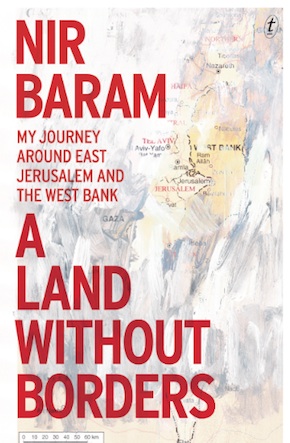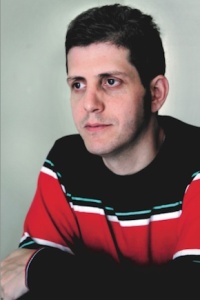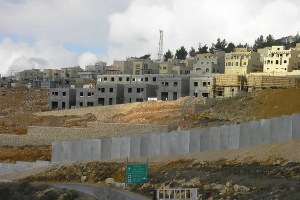Over the wall
by Nir Baram
“An engaging, fast-paced odyssey that conveys an intimate understanding of why peace remains so elusive.” Christian Science Monitor
In 2014 I decided to travel the length of the Green Line, the demarcation line agreed in the 1949 armistice agreements between Israel and its neighbours. On the other side of the Green Line is the West Bank, which Israel has now occupied for fifty years, ever since the Six-Day War in 1967. I spent some time in East Jerusalem, too, which Israel has also occupied since 1967. I set off on this journey because I wanted to learn what this place really looks like – this part of the world where I have lived all my life and where (if all goes according to plan) I will live out the rest of my days.
Starting at a very early age, all of us have been bombarded with pictures, maps and news reports about the Israeli–Palestinian conflict. We learned about injustices, wrongdoings, even killings – whether in Jenin, at the Kalandia checkpoint, or at a demonstration near Ramallah. And our immediate response was one of horror. Sometimes, in fact, it seems we’ve spent most of our lives being horrified. And yet over the past few years Israelis have started to appear fatigued by their horror and its familiar companion: their sense of helplessness. Or is it that they have tired of the horror because of the helplessness? Either way, they’ve lost interest in the Palestinians. Most Israelis, and perhaps most people around the world, have concluded that there is no chance of resolving the conflict.
The horror, the indifference and the despair have become shopworn. It’s all been said before. But the incredible thing is that the vast majority of Israelis – as well as most international spectators – know next to nothing about life on the West Bank, the area at the heart of the conflict they have spent their adult lives dissecting. Most Israelis have never visited the occupied territories, unless they were there as part of their military service, and so the debate revolves around a theoretical, ill-defined area sketched out in our political imagination, no less abstract than Syria or the Congo or so many other war-torn lands.
What has become clear in recent years is that very few of us have a comprehensive, accurate picture of the West Bank or the Green Line. This journey was my effort to examine, as frankly as possible, the connection between my own political views and the West Bank reality. I’d grown weary of the cafe discussions and the conferences at universities or in Geneva, where participants deliberate the finer points of the occupation without knowing where the Green Line actually runs, what a refugee camp looks like, how many people live in the Shomron settlement outposts, or where the separation wall cuts through Bethlehem.
I was driven by a personal motivation, too. Since the age of twenty-one, I have been writing newspaper articles, organising demonstrations, signing petitions, giving speeches at rallies against the occupation and in support of the traditional two-state solution that aims to resolve the outcomes of the 1967 war. But I had an increasing sense of discomfort: was it possible that although we kept on saying the same things, the West Bank had in fact become a different place? Moreover, as I began to suspect based on what I was hearing from the Palestinians I met, had the issues themselves shifted? I could not help questioning my own positions: were the plans I was advocating implementable anymore? Were we truly acknowledging the core of the conflict? The doubts continued to nag, and I decided I needed to visit the occupied territories. In order to stand on solid political ground – as I felt I had done for many years – and voice an honest perspective, I knew I had to go and see for myself.
***
In his fascinating book Palestinian Walks, author and lawyer Raja Shehadeh quotes William Makepeace Thackeray, who travelled the West Bank in the first half of the nineteenth century and recounted his impressions in Notes of a Journey from Cornhill to Grand Cairo: “Fear and blood, crime and punishment, follow from page to page in frightful succession. There is not a spot at which you look, but some violent deed has been done there: some massacre has been committed, some victim has been murdered, some idol has been worshipped with bloody and dreadful rites.” Thackeray’s words ring even truer almost two centuries later: on the West Bank the past engulfs all the landscapes, glistens from every hilltop, sidles into every sentence, navigates its way into every contemplation and constantly paints pictures in your mind (including some you do not understand at all).
People on both the right and the left in Israel live without a clear picture of their country’s future, or even a hazy one. A future apocalypse is ever-present in the back of the mind and sometimes gleaming in its forefront.”
What drove me to take this journey, however, was not the past but the future. Everyone in Israel is fond of pointing out doubts about its future existence. Cynicism, one-upmanship, biblical clichés and prophesies of doom characterise public discourse – as well as private conversation – about the future, and not by chance. People on both the right and the left in Israel live without a clear picture of their country’s future, or even a hazy one. A future apocalypse is ever-present in the back of the mind and sometimes gleaming in its forefront. No one seems truly able to imagine the state of things in 2040 or 2060. Most people do not even have an answer to the simplest of questions: Where will our country’s borders run and what sort of state will it be?
Israel, after all, never declared what it intended to do with the West Bank (unlike East Jerusalem, which it formally annexed after the 1967 war), and the result is a lack of definitive borders. Israel controls the West Bank through military law and might, but it has never formalised the occupied territories’ status. Yet the presence of the Israel Defense Forces (IDF) and well over half a million settlers makes it impossible to argue that it is not, in fact, part of Israel. Where, then, do Israel’s borders run? Clearly not along the pre-1967 lines, since the state now reaches much further than that. Does Israel encompass the West Bank and even beyond? Formally, no.
Yet despite this territorial and existential instability, most of my friends, including the most sceptical and pessimistic ones, have become parents in recent years, while continuing to harbour profound doubts about the country’s chances of continuing to exist, certainly in its current structure. Still, they go about their daily lives: they buy apartments, start businesses, save money for their five-year-old’s college education. There seems to be a peculiar disconnect between most Israelis’ gloomy political outlook and their day-to-day conduct. They have somehow convinced themselves that everything will stay just as it is indefinitely. “And the years were more crushed and crammed and rushed than we were,” wrote the poet Israel Pincas, “but we acted as though we were immortal, as though there were time for everything.”
I was troubled by this chasm between our bleak political future and our everyday routines – as if we lived in the shadow of the future but actually in denial of its existence. Again and again I asked my friends, political allies and adversaries: What will our future look like? What sort of country will be here. How many countries? Which ones? What laws will they have? Why don’t we try to imagine the future together, now? I came to understand that we don’t really want to talk about Israel’s political future, making do instead with generalisations, complaints and vague predictions peppered with black humour. I realised that what has evolved in Israel over the past few years is a collective repression of the future.
***
I’ve been asked whether this journey has left me more pessimistic or more optimistic. The truth is, I cannot say exactly. Perhaps I should feel more sober, and to some extent I do, but not always. After all, I saw many disheartening things, I learned how convoluted and multifarious the apparatus of the occupation is – a labyrinth that one cannot but get lost in – but I also met people who gave me hope and even inspiration, and I heard new ideas. On balance, I believe that the struggle for a political order in which Jews and Arabs can live with equal rights is far from over. If there is one thing the twentieth century has unequivocally taught us, it is that enormous changes that were previously unthinkable can occur, sometimes in the blink of an eye. There is no divine edict for eternal war in this land. I still believe that we have not done enough, that we have not shown sufficient political courage or genuinely examined fresh ideas, and that all this can still be changed. Despite the views I often heard on my journey, I have to believe that the fate of the people living here still depends on them – on us – and that we still have time.
This is an edited extract from A Land Without Borders, translated by Jessica Cohen.
 Nir Baram was born in Jerusalem in 1976. His grandfather and father were both ministers in Israeli Labour Party governments. He has worked as a journalist and an editor, and as an advocate for equal rights for Palestinians. He is the author of five novels, including Good People, which was translated into English for the first time in 2016. He has been shortlisted several times for the Sapir Prize and in 2010 he received the Prime Minister’s Award for Hebrew Literature. A Land Without Borders and Good People are published by Text. Read more.
Nir Baram was born in Jerusalem in 1976. His grandfather and father were both ministers in Israeli Labour Party governments. He has worked as a journalist and an editor, and as an advocate for equal rights for Palestinians. He is the author of five novels, including Good People, which was translated into English for the first time in 2016. He has been shortlisted several times for the Sapir Prize and in 2010 he received the Prime Minister’s Award for Hebrew Literature. A Land Without Borders and Good People are published by Text. Read more.
nirbaram.com
@NirBaram
Author portrait © Osnat Krasnansky
Jessica Cohen is a freelance translator born in England, raised in Israel and living in Denver. Her translations include critically acclaimed works by major Israeli writers including David Grossman, Etgar Keret, Rutu Modan, Dorit Rabinyan, Ronit Matalon, Amir Gutfreund and Tom Segev.
thehebrewtranslator.com


